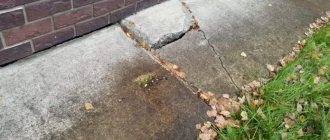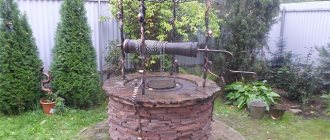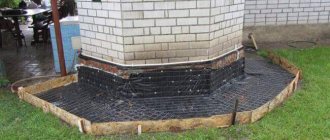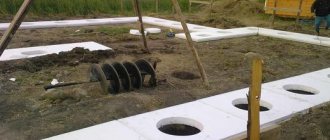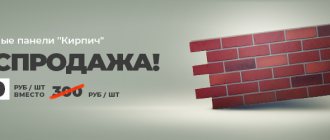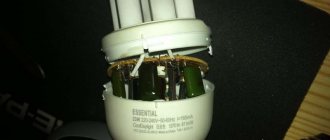The blind area is laid around the perimeter of the building. It protects the base and foundation from moisture. The blind area is made of artificial or natural stone, paving stones, tiles, and concrete. It must be strong and solid, which will ensure the performance of its functions. If damage occurs on the blind area, you can repair it yourself.
Failure to comply with installation technology
Incorrect installation. If pouring is carried out without using waterproofing, which will eliminate the possibility of moisture absorption from the ground, this will lead to its destruction. The face covering can be vulnerable if the cushion is uneven and unsealed.
Destruction occurs when the backfill is poorly compacted, uneven or the top layer is insufficiently thick. If construction work is carried out under unfavorable climatic conditions, this leads to the destruction of the blind area. At excessively high or low temperatures, it is prohibited to lay a blind area, as this can negatively affect the quality of the coating, as well as lead to disruption of the hardening process and germination of cement crystals.
If there is no leveling layer of the blind area, the protection will quickly settle. With a thin leveling layer and poor compaction, cracks form on the surface. When laying concrete, it is necessary to use a sand and gravel layer. If the concrete mixture is poured onto the ground, then due to the heaving of the soil, the protective strip is deformed.
How to fix cracks in the blind area around the house with your own hands
Repairing deep cracks in concrete
- If the cracks in the blind area are small, then after preliminary cleaning, they are filled with a liquid cement solution in a ratio of 1:1 or 1:2 with the addition of diluted PVA glue and grout.
- If the size of the cracks is average, then the repair is done differently. The surface is cleaned, the cracks are widened using a hammer drill. The resulting channels are treated with a primer, allowed to dry, and then filled with concrete.
- When detaching the covering from the plinth around the building, the resulting gaps should be filled with extruded polystyrene foam and sealed with polyurethane sealant. Grout the top with cement mortar. Repairs in this case will be more expensive.
- If the reason for the appearance of cracks in the blind area is caused by subsidence of the old coating, it should be completely destroyed in this section, soil should be added and compacted. Then restore all layers of the coating, followed by pouring concrete.
- There are times when the damage to the coating is too great and repair is no longer possible. The only thing that can be done is to lay new structures on top of the old coating. If it is impossible to make a blind area on top of the old one, you should dismantle all its layers and do the installation yourself from the very beginning, following the technology. It should be remembered that expansion joints should be installed every one and a half to two meters.
Repairing light damage in concrete
No slope of the blind area
Repair of the blind area around the house.
No tilt. When pouring the blind area, you need to ensure that there is a slope of several degrees. Otherwise, precipitation and melt water will accumulate on the surface, which will lead to the appearance of small cracks. When installing a blind area, it is recommended to install gutters on the roof, since flowing water will deform the surface.
How to repair blind areas made of various materials
The technology of repair work directly depends on the material used for the finishing coating of the multilayer structure.
Concrete
It is recommended to begin repairing a concrete blind area as soon as possible after detecting cracks and crevices in the structure. Delaying repair work aggravates the situation and can lead to destruction of the blind area.
Surface preparation. It is important not only to remove dirt and dust from the repaired area, but also to wash it with water.
We prepare a concrete solution from cement grade M200-M500, the optimal ratio of cement solution, crushed stone and water is 2.6: 1: 4.5. After preparation, the solution is suitable for repair work only for two hours - after that the solution sets and its use is impractical.
Assessing the condition of the surface - repairing small cracks consists of filling with mortar. If there is a medium-sized crack in concrete, then it must not only be cleaned, but also covered with soil, which will ensure the necessary adhesion between the base and the concrete being poured. If the crack is deep, then it can be filled with a mixture of slag, bitumen and asbestos, the optimal ratio of these ingredients is 7:1:1.5. After the mixture becomes hard, close the crack completely with concrete.
Serious faults will require a lot of effort. If the bedding has not sagged, then you can get by with repair work, that is, fill the crack with a bitumen mixture and concrete. If the soil has subsided, then you will have to dismantle part of the blind area and duplicate the layers of the lining - compact clay and sand, fill in crushed stone. After this, you will have to install the formwork and fill the area with concrete.
Dismantling the blind area
We repair the gap between the blind area and the wall in the same way - widen the gap with a hammer drill, prime the walls and fill them with concrete mortar.
Paving slabs, paving stones
When repairing the blind area of a house made of paving slabs, there are cases when one or more tiles are damaged. In this case, the cause is improper operation of this part of the foundation - when there is a strong mechanical impact on the structure, the strength of the coating is simply not enough.
Repair consists of replacing the damaged element, and it is worth checking whether the substrate is damaged.
If the substrate also subsides, it is necessary to dismantle the sand cushion and lay the layers according to all the rules. Next, we lay the dismantled elements of the finishing layer, following the technology.
Asphalt
If there is damage on the asphalt blind area, we perform the following steps: first, you must completely rid the damaged area of the asphalt covering. Next, we fill the restored surface with liquefied bitumen, after which we lay a new layer of asphalt, compacting it with a roller.
Cobblestones
If the top layer is made of cobblestones, then during the repair you will have to remove them along with the binder. If the substrate has not sagged, then it is enough to fill the freed area with crushed stone and compact it. Next, we fill the area to be restored with cement mortar, on top of which the stones are laid. The final stage of work is filling the volume between the cobblestones with mortar.
If the top layer of the blind area is made of cobblestones, then you will have to remove them along with the binder
Soft blind area
When repairing a soft blind area, there are 2 types of complexity:
- Repair work in the upper waterproof part - in this case, you can add backfill or add sand, which fills the gaps between the crushed stone. This option is relevant if the sand is washed away by melt or precipitation waters.
- Complex repairs involve replacing the waterproofing coating, which is located at a distance of 20-30 cm from the top level of the system. Such types of damage are possible due to mechanical impact on the waterproofing material, for example, when pierced by a sharp object, roots, and so on. In this case, it is necessary to remove all the dressing on the restored area and expose the waterproofing layer. We close the hole in the material with a patch and restore water resistance using glue or sealant. Alternatively, you can use double-sided tape, bitumen or polymer-bitumen mastic. The choice of material is determined by the recommendations of the manufacturer of the waterproofing layer. The next stage is the restoration of the bedding - we lay layers of sand, crushed stone and other layers that are necessary for the technical process. How to determine a waterproofing rupture? This can be judged only when the humidity in the basement increases or mold appears, but it is quite difficult to find out the location of the breakthrough.
Why do cracks and cracks appear on the blind area?
During operation, the top layer of the blind area may begin to collapse. This happens due to non-compliance with device technology, the use of low-quality materials, and untimely repair of defects that have formed. Reasons for cracking of the blind area:
- The coating is subject to thermal expansion during freezing and contraction during warm periods. As a result, heaving and movement of the soil occur, and the blind area cracks. Over time, microcracks expand more and more.
- Loose connection of the tape to the foundation. Excess moisture stagnant between the base and the blind area deforms and destroys the foundation.
- Poor compaction of the leveling layer causes soil subsidence.
- Absence or incorrect calculation of gutter parameters. Streams of water flowing from the roof create potholes in the covering.
- Overgrowth of mosses and lichens. Plants destroy the leveling layer.
Why does damage occur?
Destructive processes can begin from below, above, from the side, or inside the concrete. The difference between breakdowns is the location of the damage, the reasons that led to such an outcome. There are several options for the development of events, as a result of which the blind area was damaged.
The construction technology has been violated
The main purpose of the strip around the building is protection from moisture, which gradually destroys the blind area.
The main mistake when constructing a structure is the refusal of waterproofing - geofabric will not provide an adequate barrier to liquids.
Groundwater damages concrete if the compacted cushion of sand and crushed stone, which is designed to retain the greatest amount of moisture, was not backfilled correctly.
If the bulk materials were poured unevenly, poorly compacted, or made too thin, the concrete strip will soon be damaged.
Concreting should not be carried out in rainy, hot or cold weather. It is better if it is about 20 degrees Celsius outside, with a lot of clouds. High and low temperatures, frost, and excessive precipitation destroy the integrity of the solution. The mixture will begin to collapse from the inside even before it has completely hardened.
Incorrectly mixed solution
The strength of a concrete-filled blind area depends on the quality of the solution.
It is necessary to use only purified sand, preferably the quarry type - it has a beneficial effect on the condition of the concrete mixture.
Do not use dirty water; particles of dust and dirt greatly reduce adhesion - the components will not adhere, and it is impossible to achieve a dense fill.
Usually, the finished solution is of low grade, but cement is used as the starting material, the grade of which is at least twice as high. It is recommended to use products of at least M400 grade for work, so that the output is a mixture of about M200.
Example of ready-mixed concrete
It is necessary to take into account the ratio of components in the solution - the more water, the longer the mixture will dry, and the weaker the structure will be. Lack of water will result in terrible adhesion between dry substances. It is better to use enough liquid to obtain the consistency of thick sour cream.
Damping seam was not made
Between the blind area and the house, 1-2 cm is left for deformation of concrete and soil when the seasons change.
With the onset of cold weather, the soil often begins to heave, displacing the structure, but in the heat the concrete expands, and a crack may form between the pouring and the main building.
Visual representation of expansion joints
Along the perimeter of the protective tape, expansion joints are made every 1.5-2 meters. If you pour a concrete monolith, there will not be enough load on top to hold it in place during the period of soil heaving.
Pouring individual parts even after waiting for setting will not give results - the solution will change with the arrival of heat and will collapse.
To construct the necessary joints, spacers made of wooden boards are placed inside the formwork before concreting.
The blind area has no slope
Sloping outward from the building is required. For every meter of width of a concrete building, a difference of 2-3 degrees is maintained.
Some homeowners try to avoid a slope by installing a drainage system with storm drains inside the blind area.
The option has the right to exist, but as an additional method of drainage. If the slope is not made, water will begin to accumulate on the surface of the concrete, after heavy rain, and during the period of melting snow, the water load will be especially high.
Ribbon tilt design option
The abundance of moisture will saturate the solution through and through, with the coming frosts, under the scorching sun the structure will crack and begin to delaminate. If you don't notice the beginning of the damage, there will soon be nothing left to repair.
It is recommended to install gutters on the roof with the drain point as far as possible from the main structure. The blind area will be more intact and the base will be better protected from moisture.
There is no reinforcing frame
Laying reinforcing mesh is almost always required. Reinforcement is not a mandatory item, but it allows you to strengthen the structure.
The imposed load from passing people, animals, or heavy snowfall will be distributed not over the surface of the concrete, but through the internal reinforcing frame. The pressure on the solution will be significantly reduced, and the service life will increase.
Reinforcement
Before installing thin reinforcement, you need to insulate the blind area so that the solution does not freeze. During severe frosts, the risk of surface cracking increases; a layer of polystyrene foam or penoplex will prevent destruction. It is necessary to lay the slabs tightly to each other, treat the joints with construction sealant.
The presence of thermal insulation is also good for the foundation of the building and basement rooms - the less the ground freezes, the less the impact of cold on the main buildings.
